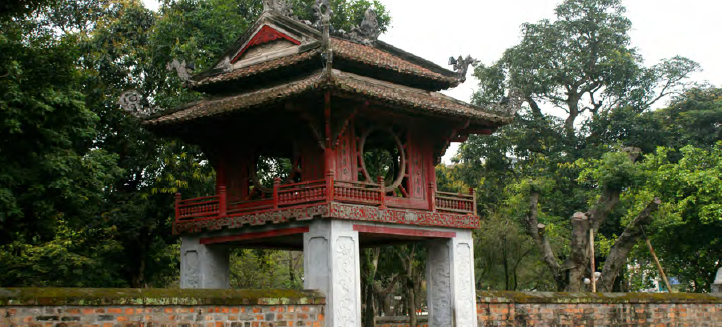Contents
Page List
Guide
Praise for The Martial Arts of Vietnam
We are truly indebted to Master Augustus Roe (V s Qung Tha,  for writing this book. In it, he not only shares the unique experiences he gained as he sought out martial artists throughout Vietnam, but also opens up for us their traditions, cultural practices, histories, stories, philosophies, and beliefs. Moreover, Augustus Roes insights into Vietnams ethnic, regional, and cultural diversity allow us to more fully appreciate the martial arts culture of Vietnams lands and peoples.
for writing this book. In it, he not only shares the unique experiences he gained as he sought out martial artists throughout Vietnam, but also opens up for us their traditions, cultural practices, histories, stories, philosophies, and beliefs. Moreover, Augustus Roes insights into Vietnams ethnic, regional, and cultural diversity allow us to more fully appreciate the martial arts culture of Vietnams lands and peoples.
Venerable Quang Huyen, Buddhist monk of X Li Pagoda, PhD in Vietnamese literature and culture, author of Dharma Mountain Buddhism & Martial Yoga
This is a very important piece of work written by someone who knows what they are writing about. It is a detailed exploration of the various Vietnamese martial arts, both foreign and indigenous, that fills a gap in the available research on combative systems. Both informative and interesting, this book will surely stimulate further research and debate on the subject. A ten out of ten!
Jamie Lee Baron Hanshi, president of the Institute of Martial Arts and Sciences, Accrington, Lancashire, United Kingdom
Augustus John Roe has done a fine job of helping us understand Vietnamese martial arts by first researching the history of Vietnam. For example, the historical relationship between China and Vietnam explains Chinese influence in Vietnamese martial arts. And knowing that three hundred thousand South Vietnamese troops fought alongside the Americans during the Vietnam conflict explains how taekwondo arrived in Vietnam. Of particular interest to me was the section on traditional Vietnamese wrestling, about which very little has been previously written. This book represents an amazing amount of research and is a valuable contribution to the body of knowledge in the field of martial arts, history, and culture.
Dr. Antonio Graceffo, PhD from Shanghai University of Sport Wushu Department, author, black belt in Cambodian martial arts
THE MARTIAL ARTS OF VIETNAM
THE MARTIAL ARTS OF VIETNAM
AN OVERVIEW OF HISTORY AND STYLES
- AUGUSTUS JOHN ROE
YMAA Publication Center
Wolfeboro, NH USA
YMAA Publication Center, Inc.
PO Box 480
Wolfeboro, New Hampshire 03894
1-800-669-8892inf
ISBN: 9781594397974 (print) ISBN: 9781594397981 (ebook)
Copyright 2020 by Augustus John Roe
All rights reserved, including the right of reproduction in whole or in part in any form.
Cover design by the author
This book typeset in Trajan and Myriad
Images by the author unless otherwise noted
Publishers Cataloging in Publication
Names: Roe, Augustus John, 1988- author.
Title: The martial arts of Vietnam : an overview of history and styles / Augustus John Roe.
Description: Wolfeboro, NH USA : YMAA Publication Center, [2020] | Includes bibliographical references.
Identifiers: ISBN: 9781594397974 (print) | 9781594397981 (Ebook) | LCCN: 2020939624
Subjects: LCSH: Martial arts--Vietnam. | Martial arts--Vietnam--History. | Martial arts--Vietnam -- Pictorial works. | Martial arts schools--Vietnam--Directories. | BISAC: SPORTS & RECREATION / Martial Arts. | HEALTH & FITNESS / Tai Chi. | HISTORY / Asia / Southeast Asia.
Classification: LCC: GV1100.73 .R64 2020 | DDC: 796.8/0957--dc23
Note to Readers
The authors and publisher of the material are NOT RESPONSIBLE in any manner whatsoever for any injury which may occur through reading or following the instructions in this manual.
The activities physical or otherwise, described in this manual may be too strenuous or dangerous for some people, and the reader(s) should consult a physician before engaging in them.
Nothing in this document constitutes a legal opinion nor should any of its contents be treated as such. While the author believes that everything herein is accurate, any questions regarding specific self-defense situations, legal liability, and/or interpretation of federal, state, or local laws should always be addressed by an attorney at law.
When it comes to martial arts, self-defense, and related topics, no text, no matter how well written, can substitute for professional, hands-on instruction. These materials should be used for academic study only.
- DEDICATED TO ISSY & ALYSSA
CONTENTS
NOTES ON THE WRITING OF NON-ENGLISH WORDS
The Vietnamese language is generally written using characters of the Latin alphabet with diacritical markings indicating tonal inflections and various vowel sounds. However, with the exception of italicized words and occasional logographs that are included alongside English translations, throughout the majority of this book the Romanized spellings of Vietnamese words are used. Therefore, words such as H Ni and H Ch Minh have been transcribed as Hanoi and Ho Chi Minh, respectively. All words written using the Vietnamese script have been included in the glossary for reference, as have specific martial arts terms written as Romanizations of other languages, such as Qi, Qigong, Chi Sao and Gi. Furthermore, the terms Master, Grandmaster and Patriarch Master have been used to refer to an instructor who has achieved mastery of an art form or a rank that designates them the title, the current or former head of a school or system and the deceased founder of an individual school or style, respectively.
INTRODUCTION
Since the beginning of recorded history, violence has been an inescapable part of human nature. In attempts to organize this violence, codified systems of combat that blend the physical components with strategy, philosophy, tradition, or other features have developed. In this book, these modern expressions of our violent nature, known as martial arts will be examined in the context of the lands we now call Vietnam.
This book will focus upon the forms of cold (i.e. non-firearm-based) martial arts that exist in various forms today. As a study of embodied culture, we will consider the ways in which the people of Vietnam find meaning in the historical narratives and modern practices of martial arts. As we shall see, the martial culture and history of the region is exciting and diverse, with everything from warring swordswomen and tiger-felling martial monks to pirates and wrestlers-turned-kings.
Upon first arriving in Vietnam more than a decade ago, I was astounded by both the range of martial arts on display and the pride the Vietnamese people took in their practices. In contrast, it was a shock to learn that the martial arts of a nation with such a rich culture of combat were so little known to the outside world.
After several years studying and then teaching Vietnamese martial arts, I found myself needing to describe these systems and as a result, wanting to learn more about them myself. I then traveled to all corners of the nation seeking out knowledge and skills. I found myself plunged into countryside wrestling contests, being thrown across dusty temple courtyards by the descendants of famous warrior clans and navigating the floodplains of the Mekong delta in search of legendary martial arts masters.

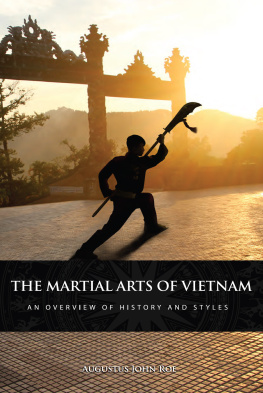




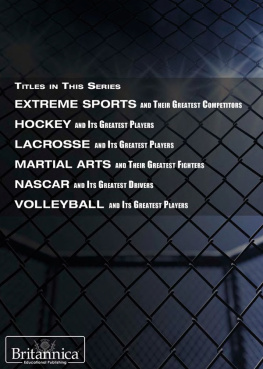


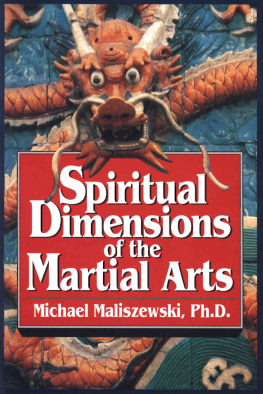
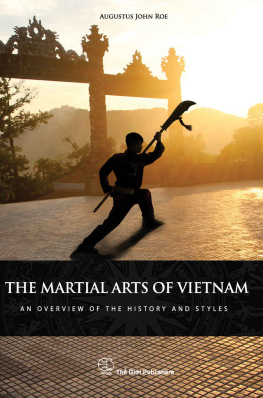
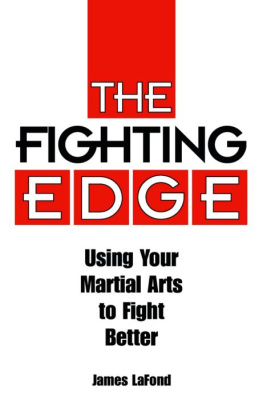
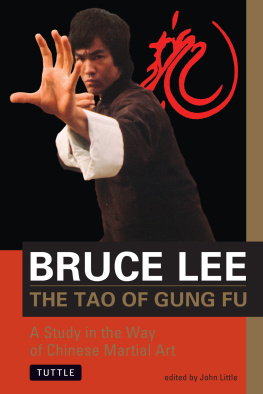

 for writing this book. In it, he not only shares the unique experiences he gained as he sought out martial artists throughout Vietnam, but also opens up for us their traditions, cultural practices, histories, stories, philosophies, and beliefs. Moreover, Augustus Roes insights into Vietnams ethnic, regional, and cultural diversity allow us to more fully appreciate the martial arts culture of Vietnams lands and peoples.
for writing this book. In it, he not only shares the unique experiences he gained as he sought out martial artists throughout Vietnam, but also opens up for us their traditions, cultural practices, histories, stories, philosophies, and beliefs. Moreover, Augustus Roes insights into Vietnams ethnic, regional, and cultural diversity allow us to more fully appreciate the martial arts culture of Vietnams lands and peoples.